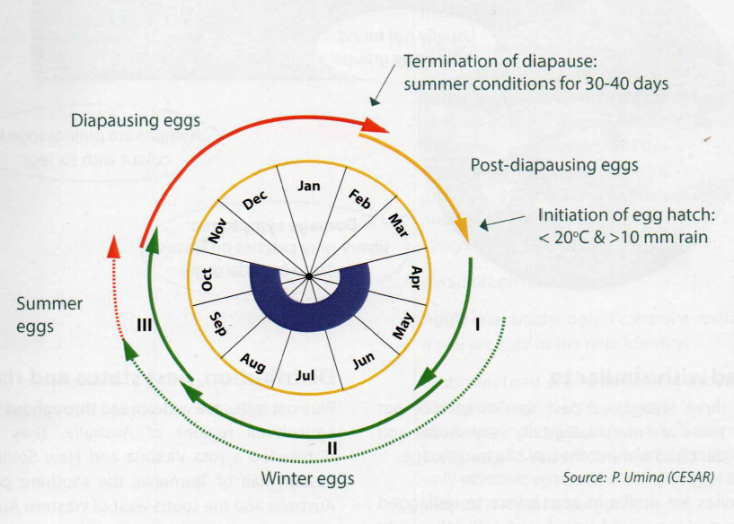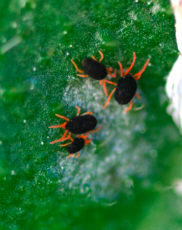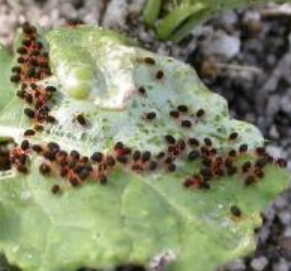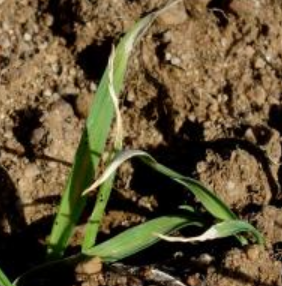Red legged earth mites: the key to effective intervention in crops and pastures
By Wendy Gill, Mixed farming officer, Forbes.
Red legged earth mites (RLEM) Acarina; Penthaleidae (halotydeus destructor) are one of the most important mites’ pests of grain crops and pasture in Central West NSW. We are now in autumn and this is an optimal time to monitor and implement targeted controls for RLEM to stop them heading to adulthood.
We see RLEM activity increase from now into autumn, especially with favourable conditions such as after rainfall events and while warmer mean daily temperature of 21 degrees or greater continue. If you have received some summer rainfall events; this may have allowed significant numbers of over-summering eggs to be laid as show in figure 1 (Source: P. Umina, Cesar 2018); which will now have ideal conditions to hatch after diapausing over the summer period.

Figure 1: Typical lifecycle of redlegged earth mites in Southern Australia (Source: P.Umina (Cesar 2018).
RLEM activity will continue through autumn as crops and pastures germinate through to late spring in the Southern section of Central West region as shown above. Monitoring and taking targeted action early will help reduce losses to young germinating crops. For effective monitoring and control you need to understand the lifecycle stages of your target pest and know how to correctly identify your species. This will allow you to take advantage of strategic control options that suit RLEM in their lifecycle.
How do I identify RLEM?
Red legged earth mites are part of the mites Acarina family, which because of their extensive habitat and small visual size, can be difficult to identify. Like other mites in the family, RLEM have a nymph and adult life cycle stage, they have initially 6 pinkish – orange shaded legs and their larvae resemble the same shape as adults but are not yet fully developed.
Young newly hatched larvae can be as small as 0.2 millimetres long and can be hard to visibly see but have a body shape best described as a globular, black velvet body. They undergo three nymphal stages to reach adulthood and a full body length of 1 millimetre and 0.6-millimetre-wide in size, and during the nymphal stages they gain two more legs to have 8 distinctive red legs by maturity as seen in figure 2 (Umina P, Cesar 2017).

Figure 2: Redlegged Earth Mites (RLEM) (Source Credit: A Weeks – CESAR, Umina, P, Agriculture VIC, 2017).
Red legged earth mites are often confused with other mite such as the blue oat mites Acarina: Penthaleidae (Penthaleus spp) or balaustium mite which are all have similar characteristics; however correct identification is important as different mite species respond differently to different control options such as insecticide or miticides.
The most important distinguishing characteristic of RLEM is that they generally tend to feed in group clusters and not individually as compared to other species of mites. Some clusters can have up to 30 RLEM feeding in the same area at any one time.
What damage signs should I look for in crop?
Most damage is done to crops and pastures by RLEM at establishment stages of these crops, which reduces the seedling development and long-term survival. Monitoring for RLEM should occur regularly in crops three weeks after emergence. However, in spring, pastures can also be susceptible, particularly hard seeded legumes. The seed set can be impacted by heavy feeding damage if RLEM threshold control levels are not kept to a minimal level. RLEM affect a large variety of crops including canola, cereals- wheat, barley, oats, lupins, faba beans, field peas, sunflowers, lucerne, vetch, some grasses and pasture legume seedlings. Importantly weed species such as cape weed, Paterson’s curse are also reported to be hosts as well. So ensuring you implement good border and fence line control actions will ensure these “green bridge” weeds do not give these mites an added host habitat advantage over your emerging crops.
The most noticeable features of RLEM in-crop damage is caused by their feeding and is seen as silvering or a white discolouration of leaves as shown in figure 3 (Micic S. 2015).

Figure 3: RLEM & leaf damage “Silvering” effect on emerging crop example. (Source: Micic, S. DPIRD 2015).
The “silvering” is often mistaken for frost damage as shown in figure 4 (Micic, S. 2015). In heavy infestations you may also see plant leaf distortion and shrivelling or death of young seedlings.
The key is to get out in your paddocks and look at your emerging plants. The best times to check for mites are in the mornings, when mites are feeding on leaves, and on overcast days as well. As the day warms up, the mites take shelter in the leaf sheaths of plants and in organic debris. Also inspect the soil for mites and inspect edges of crops.

Figure 4: RLEM damage in emerging cereal crop, leaf tips show similar signs to frost damage. (source: Micic, S. DPIRD 2015)
What are the control options?
To help producers manage resistance issues of mites to some pyrethroid chemical options, producers should be using thresholds to assist with decision making around control actions and types of chemicals. Arthur et al (2015) noted economic thresholds will change across crop types, but most studies have been done in relation to canola. In the additional resources section below this article; The Cesar Pest Note and TIMRITE® tool are great resources for assisting with working out thresholds for your crop.
It is important to note that some crops including wheat and canola have shown, under some circumstances, to have the ability to compensate for crop damage from RLEM (Cesar 2018). Therefore, working to threshold’s becomes important before using an insecticide or miticide, and your choice of varieties is also important if you have a known paddock history of RLEM problems. Using tools like TIMERITE ® in RLEM chemical control decisions is also advantageous as it is specific to your farm location and operation. However, it is important to note that this predictive tool does not help producers with other mite control strategies, for example control of Blue oat mite.
There are chemical, biological and management practices options as part of integrated pest management tool kit for RLEM. Producers may consider using seed dressings and targeting key strategic spray timing window’s in springtime prior to the cropping seasons. If producers do opt for a seed dressing, producers should always read the label and consider any grazing withholding periods of seed dressings. These methods are all effective control measures to reduce RLEM infestations and damage levels in crops and pastures, because of the alignment of decisions based on the pest’s lifecycle.
Knowing the lifecycle of these pests and correctly identifying the RLEM mite from other mite species in crops and pastures is important. The economic damage of these pests can be managed through aligning lifecycle stages of this pest to exploit its weaknesses. This gives producers control options and time from careful monitoring for early intervention to minimise the mite damage. If you have any concerns please speak to your local advisor, agronomist or LLS Ag staff member to find out more information.
Additional Information
Cesar- Pest note Red Legged Earth Mites, 2019:
http://cesaraustralia.com/sustainable-agriculture/pestnotes/insect/Redlegged-earth-mite
TIMERITE®
References
Arthur A, Hoffmann A, Umina P (2015) Challenges in devising economic spray thresholds for a major pest of Australian canola, the redlegged earth mite (halotydeus destructor). Pest Management Science 71: 1462-1470
I Spy- Insects of Southern Australian Broadacre Farming Systems Identification Manual & Education resource, 2nd Edn, Department of Primary Industries, South Australia, Department of Primary Industries & Regional Development Western Australia & Cesar Pty Ltd. 2018, Section 4: p74 – 77.
Cesar, 2018 – Pest note: Red Legged earth mites, 2019: http://cesaraustralia.com/sustainable-agriculture/pestnotes/insect/Redlegged-earth-mite
Umina, P 2018, I Spy; Insects of Southern Australian Broadacre Farming Systems Identification Manual & Education resource, 2nd edn, Department of Primary Industries, SA, Department of Primary Industries & Regional Development WA & Cesar Pty Ltd, Section 4, pp 77.
Grains Research & Development Corporation 2013, Prevent redlegged earth mite resistance, Grains Research Development Corporation, viewed date 8th April 2020, <https://grdc.com.au/archive/key-issues/prevent-redlegged-earth-mite-resistance>
Micic, S, 2015, Department of Primary Industries and Regional Development, viewed 8th April 2020, <https://www.agric.wa.gov.au/mycrop/diagnosing-redlegged-earth-mite>
Umina, P, (Weeks A-CESAR) 2007, AG0414 -Redlegged Earth Mite, Agriculture Victoria, viewed 8th April 2020,<http://agriculture.vic.gov.au/agriculture/pests-diseases-and-weeds/pest-insects-and-mites/redlegged-earth-mite>.